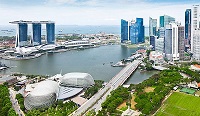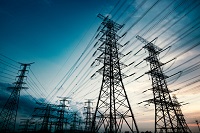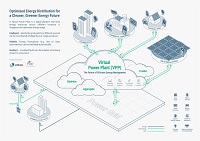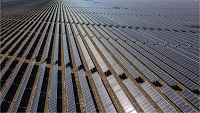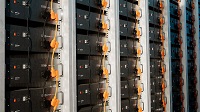EMA is committed to fostering a clean energy future for Singapore. Beyond shaping energy policies and fostering partnerships, we uphold corporate sustainability to support Singapore’s net zero goal.
Corporate Environmental Sustainability Performance and Targets
EMA’s corporate environmental sustainability targets are aligned with the sustainability targets in carbon abatement and resource efficiency for public sector agencies under the GreenGov.SG initiative.
We track our electricity and water consumption annually, using the average consumption from FY2018 to FY2020 as the baseline. In FY2024, we also began tracking waste generation, which serves as the baseline for our waste reduction targets.
In line with the GreenGov.SG targets for the public sector, EMA aims to peak carbon emissions by around 2025 and achieve net zero emissions by 2045. By 2030, we target a 10% reduction in our electricity and water consumption and a 30% reduction in waste generation from our respective baselines.
EMA's Performance
| Mandatory Performance Indicators | Average of FY2018 – FY2020 | FY2021 | FY2022 | FY2023 | FY2024 |
|---|---|---|---|---|---|
GHG emissions (kt CO2e) – Scope 1 (Direct Carbon Emission)
|
0.0017 | 0.0025 | 0.0021 | 0.0024 | 0.0006 |
GHG emissions (kt CO2e) – Scope 2 (Indirect Carbon Emission)
|
0.374 | 0.317 | 0.338 | 0.342 | 0.374 |
| Electricity consumption (kWh) | 918,535 | 776,265 | 811,401 | 820,809 | 908,263 |
| Energy Utilisation Index (EUI) | 159 | 135 | 141 | 142 | 156 |
| Water consumption (cu m | 2,661.96 | 2,358.92 | 2,437,49 | 2,888.11 | 2,799 |
| Water Efficiency Index (WEI) | 7.19 | 6.38 | 6.41 | 7.44 | 7.56 |
| Waste Generation (kg) | N.A.* | N.A.* | N.A.* | N.A.* | 10,126 |
| Waste Generation & Waste Disposal Index (WDI)* | N.A.* | N.A.* | N.A.* | N.A.* | 0.12 |
*Annual waste generation data is not available specifically for EMA’s office premises, as EMA’s office premises are tenanted premises which are part of a larger estate comprising various other tenanted premises and waste removal for the entire estate is under the purview of the landlord for the estate. EMA has only commenced the tracking of waste generation and disposal data specifically for EMA’s office premises waste collection data from October 2024 onwards. The waste generation data for FY2024 has been estimated by calculating the average monthly waste generated from October 2024 to March 2025. This average was then annualised by multiplying it by 12 to derive the projected total for FY2024.
Carbon Emissions
EMA achieved a substantial decrease in Scope 1 carbon emissions in FY2024, with corporate motor vehicle mileage falling to 2,274 kilometres (km), down from 8,854 km in FY2023, resulting in a drop in fuel consumption of 252.13 litres. This decline reflects EMA’s efforts to reduce emissions through changes in our operational practices. From September 2024, EMA fully ceased generating Scope 1 emissions, following theretirement of our corporate motor vehicle.
Scope 2 carbon emissions, which came primarily from office electricity consumption, increased by 9.36% from 0.342 kt CO₂e in FY2023 to 0.374 kt CO₂e in FY2024, though this level remained unchanged from our baseline. This increase was driven by a growing workforce and increased office occupancy. Other contributing factors include our aging infrastructure, particularly our air-conditioning system, which contributed to higher energy usage.
Electricity Consumption
Electricity consumption in FY2024 was 1.12% lower than the baseline average despite increasing by 10.65% compared to FY2023. This is attributed to a growing workforce in the office and an aging air-conditioning system, which has become less energy-efficient over time.
Despite these challenges, EMA has implemented several energy-saving measures, including setting air-conditioning units to 25°C, using LED lighting and installing timers
on water boilers and air purifiers, to reduce energy consumption.
Looking ahead, EMA is expected to relocate to a certified Green Mark Super Low Energy office building by end-2025, which is projected to significantly improve energy efficiency and reduce electricity consumption.
Water Consumption
EMA’s water consumption for FY2024 remained relatively consistent, with a slight increase of 3.08% compared to FY2023. While this represents a 5.15% increase over the baseline, the overall usage pattern has been consistent, with no significant fluctuationsobserved throughout the year. The modest rise is primarily attributed to a growing workforce and more staff returning to the office more frequently.
EMA continues to prioritise water conservation. All water taps in the office, such as those in restrooms and pantries, have been replaced with 3-ticks water-saving taps, which are designed to significantly reduce water usage without compromising functionality.
Waste Generation
Previously, annual waste generation was not available specifically for EMA’s office premises as our office is part of a larger tenanted estate with waste removalmanaged by the landlord. To address this, EMA has worked with our cleaning service provider to begin recording waste generation data specific to our office premises. FY2024 marked the baseline year for this effort, with approximately 10,126 kilograms of waste generated across our office premises. We aim to reduce our waste generation by 30% by 2030.
EMA has implemented various measures in our office premises to reduce waste generation and encourage greater efforts at recycling. For instance, we replaced individual waste bins at staff workstations and rooms with centralised waste and recycling bins located at common areas. We are also putting in place arrangements to enable us to track waste generation and disposal within the office premises.
EMA's Commitment to Environmental Sustainability
EMA is deeply committed to environmental sustainability. Beyond reducing electricity and water consumption and waste generation, we also implement several initiatives to reduce our environmental footprint.
Green Procurement
We have adopted green procurement practices by procuring printing paper accredited with the Enhanced Singapore Green Label by the Singapore Environment Council. All electrical appliances and lights in our office premises are rated ‘energy efficient’ under the National Environment Agency’s Mandatory Energy Labelling Scheme.
Optimising Office Space Usage and Resources
In FY2024, EMA continued to optimise office space utilisation by promoting hotdesking and shared workstations. This flexible arrangement allowed us to accommodate a growing workforce without major infrastructure changes.
With plans to relocate to a new office by end-2025, we made a conscious effort to avoid extensive renovation works at our current premises. Instead, minor modifications were made to existing single-user workstations to accommodate two users. This approach avoided the need for furniture replacement and disruptive electrical works. Our resource-conscious strategy reflects EMA’s commitment to sustainability.
